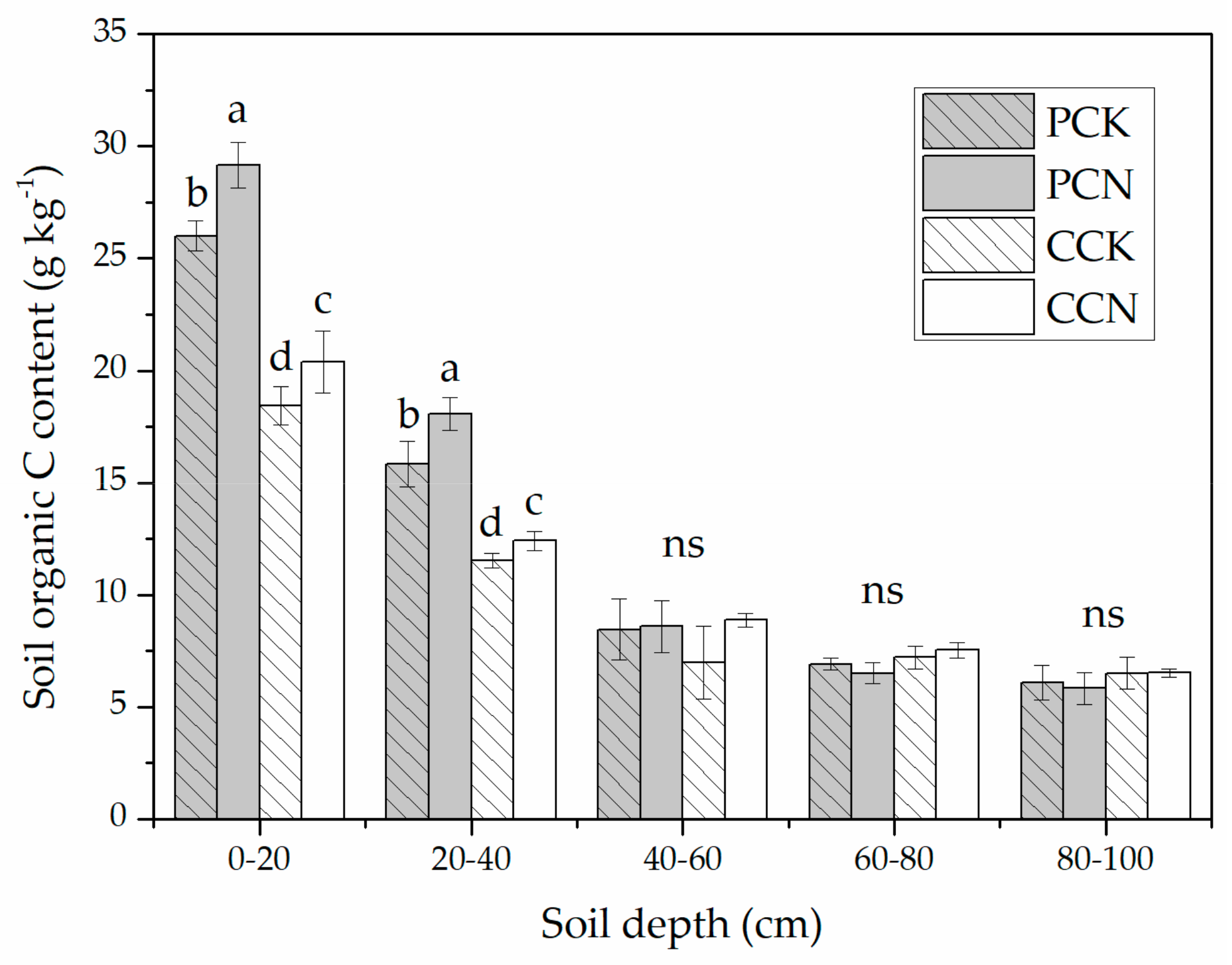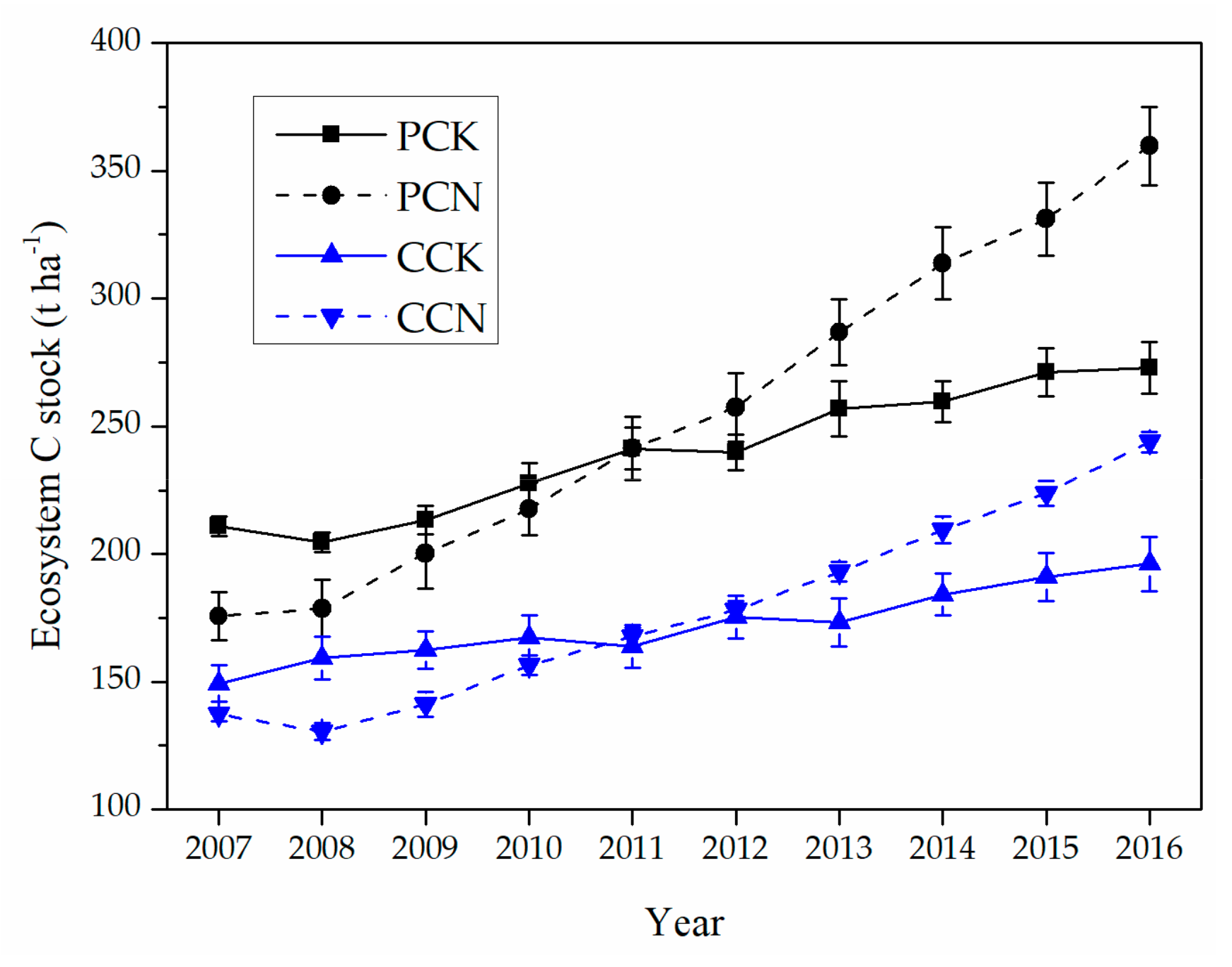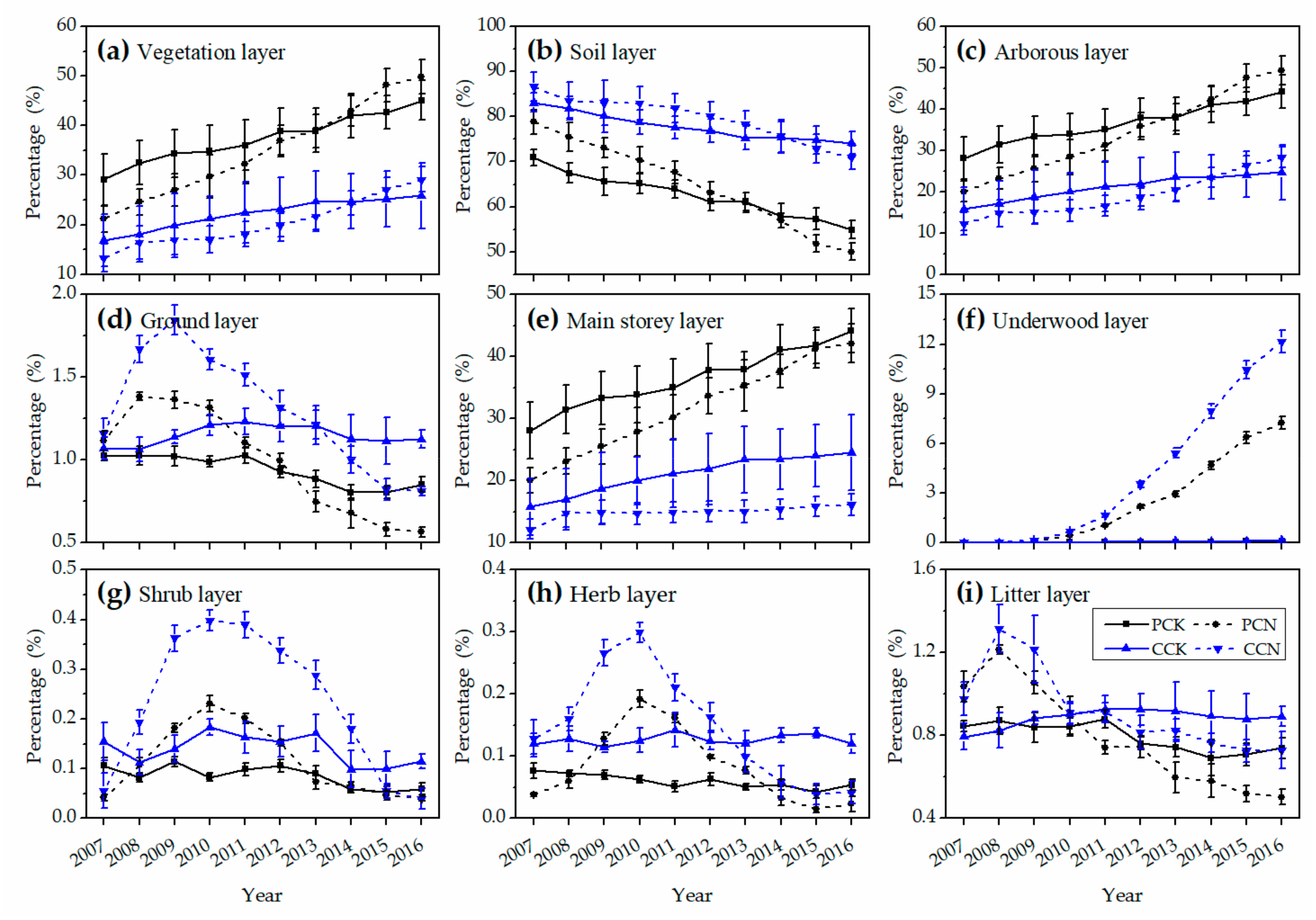The Impact of Near Natural Forest Management on the Carbon Stock and Sequestration Potential of Pinus massoniana (Lamb.) and Cunninghamia lanceolata (Lamb.) Hook. Plantations
Abstract
1. Introduction
2. Materials and Methods
2.1. Study Site
2.2. Experimental Design
2.3. Sampling, Measurement and Statistical Analysis
2.3.1. Determination of Tree Biomass
2.3.2. Measurement of Understory Vegetation Biomass and Litter Quantity
2.3.3. Soil Sampling
2.3.4. Determination of C Content and Stock
2.3.5. Statistical Analysis
3. Results
3.1. C Stock of Each Component in the Forest Ecosystem
3.2. Ecosystem C Stock and Its Allocation
3.3. Relationship between Ecosystem C Stock and Its Components
4. Discussion
4.1. Effects of NNFM on Vegetation C Stock
4.2. Effects of NNFM on Soil C Stock
4.3. Long-Term Effects of NNFM on Ecosystem C Stock
5. Conclusions
Author Contributions
Funding
Acknowledgments
Conflicts of Interest
References
- IPCC. Climate Change 2014: Synthesis Report; Contribution of Working Groups I, II, and III to the Fifth Assessment Report of the Intergovernmental Panel on Climate Change; IPCC: Geneva, Switzerland, 2014. [Google Scholar]
- Noormets, A.; Epron, D.; Domec, J.C.; McNulty, S.G.; Fox, T.; Sun, G.; King, J.S. Effects of forest management on productivity and carbon sequestration: A review and hypothesis. For. Ecol. Manag. 2015, 355, 124–140. [Google Scholar] [CrossRef]
- Liu, S.; Wu, S.; Wang, H. Managing planted forests for multiple uses under a changing environment in China. N. Z. J. For. Sci. 2014, 44, S3. [Google Scholar] [CrossRef]
- He, Y.; Qin, L.; Li, Z.; Liang, X.; Shao, M.; Tan, L. Carbon storage capacity of monoculture and mixed-species plantations in subtropical China. For. Ecol. Manag. 2013, 295, 193–198. [Google Scholar] [CrossRef]
- Wang, H.; Liu, S.; Mo, J.; Wang, J.; Makeschin, F.; Wolff, M. Soil organic carbon stock and chemical composition in four plantations of indigenous tree species in subtropical China. Ecol. Res. 2010, 25, 1071–1079. [Google Scholar] [CrossRef]
- Liu, L.; Duan, Z.; Xu, M.; Hu, J.; Wang, S.; Hu, Z.; Zhang, Q.; Wang, S. Effect of monospecific and mixed Cunninghamia lanceolata plantations on microbial community and two functional genes involved in nitrogen cycling. Plant Soil 2010, 327, 413–428. [Google Scholar] [CrossRef]
- Jacobson, S. Addition of stabilized wood ashes to Swedish coniferous stands on mineral soils—Effects on stem growth and needle nutrient concentrations. Silva Fenn. 2003, 37, 437–450. [Google Scholar] [CrossRef]
- Tian, D.; Xiang, W.; Chen, X.; Yan, W.; Fang, X.; Kang, W.; Dan, X.; Peng, C.; Peng, Y. A long-term evaluation of biomass production in first and second rotations of Chinese fir plantations at the same site. Forestry 2011, 84, 411–418. [Google Scholar] [CrossRef]
- Zhang, W.; Wang, S. Effects of NH4+ and NO3−on litter and soil organic carbon decomposition in a Chinese fir plantation forest in South China. Soil Biol. Biochem. 2012, 47, 116–122. [Google Scholar] [CrossRef]
- Wang, H.; Liu, S.; Wang, J.; You, Y.; Yang, Y.; Shi, Z.; Huang, X.; Zheng, L.; Li, Z.; Ming, A.; et al. Mixed-species plantation with Pinus massoniana and Castanopsis hystrix accelerates C loss in recalcitrant coniferous litter but slows C loss in labile broadleaf litter in southern China. For. Ecol. Manag. 2018, 422, 207–213. [Google Scholar] [CrossRef]
- Emborg, J.; Christensen, M.; Heilmannclausen, J. The structural dynamics of Suserup Skov, a near-natural temperate deciduous forest in Denmark. For. Ecol. Manag. 2000, 126, 173–189. [Google Scholar] [CrossRef]
- Brunet, J.; Fritz, Ö.; Richnau, G. Biodiversity in European beech forests—a review with recommendations for sustainable forest management. Ecol. Bull. 2010, 53, 77–94. [Google Scholar]
- Galik, C.S.; Jackson, R.B. Risks to forest carbon offset projects in a changing climate. Forest Ecol. Manag. 2009, 257, 2209–2216. [Google Scholar] [CrossRef]
- Ming, A.; Zhang, Z.; Chen, H.; Zhang, X.; Yi, T.; Yong, S. Effects of thinning on the biomass and carbon storage in Pinus massoniana plantation. Sci. Silvae Sin. 2013, 49, 1–6. [Google Scholar]
- Clarke, N.; Gundersen, P.; Jönsson-Belyazid, U.; Kjønaas, O.J.; Persson, T.; Sigurdsson, B.D.; Stupak, I.; Vesterdal, L. Influence of different tree-harvesting intensities on forest soil carbon stocks in boreal and northern temperate forest ecosystems. For. Ecol. Manag. 2015, 351, 9–19. [Google Scholar] [CrossRef]
- Zhang, X.; Guan, D.; Li, W.; Sun, D.; Jin, C.; Yuan, F.; Wang, A.; Wu, J. The effects of forest thinning on soil carbon stocks and dynamics: A meta-analysis. For. Ecol. Manag. 2018, 429, 36–43. [Google Scholar] [CrossRef]
- Nilsen, P.; Strand, L.T. Thinning intensity effects on carbon and nitrogen stores and fluxes in a Norway spruce (Picea abies (L.) Karst.) stand after 33 years. For. Ecol. Manag. 2008, 256, 201–208. [Google Scholar]
- Jurgensen, M.; Tarpey, R.; Pickens, J.; Kolka, R.; Palik, B. Long-term effect of silvicultural thinnings on soil carbon and nitrogen pools. Soil Sci. Soc. Am. J. 2012, 76, 1418. [Google Scholar] [CrossRef]
- Ming, A.; Jia, H.; Zhao, J.; Tao, Y.; Li, Y. Above- and below-ground carbon stocks in an indigenous tree (Mytilaria laosensis) plantation chronosequence in subtropical China. PLoS ONE 2014, 9, e109730. [Google Scholar] [CrossRef]
- Wang, H.; Liu, S.; Wang, J.; Shi, Z.; Lu, L.; Zeng, J.; Ming, A.; Tang, J.; Yu, H. Effects of tree species mixture on soil organic carbon stocks and greenhouse gas fluxes in subtropical plantations in China. For. Ecol. Manag. 2013, 300, 4–13. [Google Scholar] [CrossRef]
- Berger, T.W.; Neubauer, C.; Glatzel, G. Factors controlling soil carbon and nitrogen stores in pure stands of Norway spruce (Picea abies) and mixed species stands in Austria. For. Ecol. Manag. 2002, 159, 3–14. [Google Scholar] [CrossRef]
- Mao, R.; Zeng, D.; Ai, G.; Yang, D.; Li, L.; Liu, Y. Soil microbiological and chemical effects of a nitrogen-fixing shrub in poplar plantations in semi-arid region of Northeast China. Eur. J. Soil Biol. 2010, 46, 325–329. [Google Scholar] [CrossRef]
- Da, L.; Zuomin, S.; Weixia, W.; Shirong, L.; Lihua, L.; Angang, M.; Haolong, Y. Carbon and nitrogen storage in monoculture and mixed young plantation stands of Erythrophleum fordii and Pinus massoniana in subtropical China. Forests 2015, 35, 6051–6059. [Google Scholar]
- He, Y.; Liang, X.; Qin, L.; Li, Z.; Shao, M.; Tan, L. Community characteristics and soil properties of coniferous plantation forest monocultures in the early stages after close-to-nature transformation management in southern subtropical China. Acta Ecol. Sin. 2013, 33, 2484–2495. [Google Scholar]
- Berger, T.W.; Inselsbacher, E.; Mutsch, F.; Pfeffer, M. Nutrient cycling and soil leaching in eighteen pure and mixed stands of beech (Fagus sylvatica) and spruce (Picea abies). For. Ecol. Manag. 2009, 258, 2578–2592. [Google Scholar] [CrossRef]
- Ming, A.; Yang, Y.; Liu, S.; Wang, H.; Li, Y.; Li, H.; Nong, Y.; Cai, D.; Jia, H.; Tao, Y.; et al. Effects of near natural forest management on soil greenhouse gas flux in Pinus massoniana (Lamb.) and Cunninghamia lanceolata (Lamb.) Hook. plantations. Forests 2018, 9, 229. [Google Scholar]
- Kang, B.; Liu, S.; Cai, D.; Lu, L. Characteristics of biomass, carbon accumulation and its spatial distribution in Cunninghamia lanceolata forest ecosystem in low subtropical area. Sci. Silvae Sin. 2009, 45, 147–153. [Google Scholar]
- Ming, A.; Liu, S.; Nong, Y.; Cai, D.; Jia, H.; Huang, D.; Wang, Q.; Nong, Z. Comparison of carbon storage in juvenile monoculture and mixed plantation stands of three common broadleaved tree species in subtropical China. Acta Ecol. Sin. 2015, 35, 180–188. [Google Scholar]
- Pansu, M.; Gautheyrou, J. Handbook of Soil Analysis. Mineralogical, Organic and Inorganic Methods; Springer: Berlin/Heidelberg, Germany; New York, NY, USA, 2006. [Google Scholar]
- Peichl, M.; Arain, M.A. Above-and belowground ecosystem biomass and carbon pools in an age-sequence of temperate pine plantation forests. Agric. For. Meteorol. 2006, 140, 51–63. [Google Scholar] [CrossRef]
- Nicoll, B.; Connolly, T.; Gardiner, B. Changes in spruce growth and biomass allocation following thinning and guying treatments. Forests 2019, 10, 253. [Google Scholar] [CrossRef]
- Angst, G.; Messinger, J.; Greiner, M.; Häusler, W.; Hertel, D.; Kirfel, K.; Kögel-Knabner, I.; Leuschner, C.; Rethemeyer, J.; Mueller, C.W. Soil organic carbon stocks in topsoil and subsoil controlled by parent material, carbon input in the rhizosphere, and microbial-derived compounds. Soil Biol. Biochem. 2018, 122, 19–30. [Google Scholar] [CrossRef]
- Trivedi, P.; Anderson, I.C.; Singh, B.K. Microbial modulators of soil carbon storage: Integrating genomic and metabolic knowledge for global prediction. Trends Microbiol. 2013, 21, 641–651. [Google Scholar] [CrossRef]
- Wiesmeier, M.; Urbanski, L.; Hobley, E.; Lang, B.; von Lützow, M.; Marin-Spiotta, E.; van Wesemael, B.; Rabot, E.; Ließ, M.; Garcia-Franco, N.; et al. Soil organic carbon storage as a key function of soils—A review of drivers and indicators at various scales. Geoderma 2019, 333, 149–162. [Google Scholar] [CrossRef]
- Jandl, R.; Lindner, M.; Vesterdal, L.; Bauwens, B.; Baritz, R.; Hagedorn, F.; Johnson, D.W.; Minkkinen, K.; Byrne, K.A. How strongly can forest management influence soil carbon sequestration? Geoderma 2007, 137, 253–268. [Google Scholar] [CrossRef]
- Huang, X.; Liu, S.; Wang, H.; Hu, Z.; Li, Z.; You, Y. Changes of soil microbial biomass carbon and community composition through mixing nitrogen-fixing species with Eucalyptus urophylla in subtropical China. Soil Biol. Biochem. 2014, 73, 42–48. [Google Scholar] [CrossRef]
- Cao, J.; Wang, X.; Tian, Y.; Wen, Z.; Zha, T. Pattern of carbon allocation across three different stages of stand development of a Chinese pine (Pinus tabulaeformis) forest. Ecol. Res. 2012, 27, 883–892. [Google Scholar] [CrossRef]
- Tang, X.; Zhao, X.; Bai, Y.; Tang, Z.; Wang, W.; Zhao, Y.; Wan, H.; Xie, Z.; Shi, X.; Wu, B.; et al. Carbon pools in China’s terrestrial ecosystems: New estimates based on an intensive field survey. Proc. Natl. Acad. Sci. USA 2018, 115, 4021–4026. [Google Scholar] [CrossRef]



| Year | Management | Plantation Type | |||
|---|---|---|---|---|---|
| PCK † | PCN † | CCK † | CCN † | ||
| 1993 | Afforestation | 2500 trees ha−1 | 2500 trees ha−1 | 2500 trees ha−1 | 2500 trees ha−1 |
| 1993–1995 | Tending for new plantations | 6 times | 6 times | 6 times | 6 times |
| 2000 | Released thinning | 1600 trees ha−1 | 1600 trees ha−1 | 1600 trees ha−1 | 1600 trees ha−1 |
| 2004 | Increment felling | 1200 trees ha−1 | 1200 trees ha−1 | 1200 trees ha−1 | 1200 trees ha−1 |
| 2007 | Intensity thinning | No 1200 trees ha−1 | Yes 600 trees ha−1 | No 1200 trees ha−1 | Yes 600 trees ha-1 |
| 2008 | Complementary planting | No | Planting Q. griffithii and E. fordii with 300 trees ha−1, respectively | No | Planting Q. griffithii and E. fordii with 300 trees ha−1, respectively |
| 2009 | Tending | No | 2 times | No | 2 times |
| 2016 | Average DBH ‡ | 22.2 ± 1.3 cm for P. massoniana | 32.2 ± 1.6 cm for P. massoniana | 17.1 ± 2.1 cm for C. lanceolata | 22.3 ± 0.8 cm for C. lanceolata |
| 2016 | Average height | 16.7 ± 0.5 m for P. massoniana | 17.3 ± 0.7 m for P. massoniana | 17.1 ± 0.4 m for C. lanceolata | 17.2 ± 0.4 m for C. lanceolata |
| Organ | Regression Equation | Number of Sampled Trees | R2 | F Value | p Value |
|---|---|---|---|---|---|
| Stem | W = 0.027(D2H) − 0.125 † | 9 | 0.981 | 379.405 | <0.001 |
| Branch | W = 0.013(D2H) − 0.354 † | 9 | 0.911 | 72.487 | <0.001 |
| Leaf | W = 0.004(D2H) + 0.169 † | 9 | 0.979 | 332.336 | <0.001 |
| Root | W = 0.009(D2H) − 0.35 7 † | 9 | 0.863 | 44.145 | <0.001 |
| Whole tree | W = 0.054(D2H) − 0.666 † | 9 | 0.969 | 225.052 | <0.001 |
| Organ | PCK † | PCN † | CCK † | CCN † |
|---|---|---|---|---|
| Stem | 476.6 ± 16.0 a | 481.2 ± 30.2 a | 486.4 ± 19.4 a | 488.2 ± 14.3 a |
| Bark | 475.3 ± 13.8 a | 488.1 ± 6.9 a | 459.3 ± 12.7 b | 464.1 ± 12.4 b |
| Branch | 465.4 ± 18.2 a | 470.2 ± 11.9 a | 460.5 ± 18.5 a | 456.0 ± 11.6 a |
| Leaf | 491.7 ± 13.1 b | 479.6 ± 10.7 b | 513.3 ± 15.7 a | 513.0 ± 17.9 a |
| Root | 425.6 ± 14.3 b | 426.3 ± 12.8 b | 442.8 ± 10.2 a | 448.2 ± 14.2 a |
| Layer | Component | PCK † | PCN † | CCK † | CCN † |
|---|---|---|---|---|---|
| Shrub layer | Above-ground | 435.3 ± 43.5 a | 414.2 ± 19.2 a | 365.3 ± 34.2 b | 429.4 ± 24.6 a |
| Below-ground | 442.0 ± 29.7 a | 426.8 ± 34.1 a | 407.0 ± 26.7 a | 438.3 ± 36.1 a | |
| Herb layer | Above-ground | 420.7 ± 21.9 a | 400.7 ± 11.5 a | 419.3 ± 19.4 a | 400.3 ± 13.7 a |
| Below-ground | 343.1 ± 31.8 a | 345.0 ± 31.1 a | 342.5 ± 23.7 a | 341.0 ± 12.3 a | |
| Litter layer | Un-decomposed | 496.4 ± 16.6 a | 435.4 ± 37.8 b | 491.6 ± 14.1 a | 428.6 ± 33.2 b |
| Semi-decomposed | 434.6 ± 26.1 a | 413.9 ± 38.2 b | 416.4 ± 21.8 b | 394.9 ± 18.7 b |
| Layer | Component | PCK † | PCN † | CCK † | CCN † |
|---|---|---|---|---|---|
| Arborous layer | Main story | 120.44 ± 9.71 b | 151.62 ± 11.4 a | 48.15 ± 12.03 c | 39.33 ± 4.37 c |
| Underwood | 0.23 ± 0.01 d | 26.06 ± 1.41 b | 0.32 ± 0.02 c | 29.68 ± 1.60 a | |
| Sum | 120.67 ± 10.91 b | 177.68 ± 12.35 a | 48.47 ± 13.17 d | 69.01 ± 6.12 c | |
| Ground layer | Shrub | 0.16 ± 0.03 ab | 0.14 ± 0.02 ab | 0.22 ± 0.04 a | 0.10 ± 0.05 b |
| Herb | 0.15 ± 0.02 b | 0.08 ± 0.02 c | 0.24 ± 0.03 a | 0.10 ± 0.05 bc | |
| Litter | 2.02 ± 0.14 a | 1.81 ± 0.13 ab | 1.75 ± 0.09 b | 1.78 ± 0.22 b | |
| Sum | 2.33 ± 0.23 a | 2.04 ± 0.11 a | 2.21 ± 0.21 a | 1.98 ± 0.17 a | |
| Soil layer | 0–20 cm | 55.40 ± 3.36 bc | 66.80 ± 4.07 a | 51.09 ± 3.05 c | 63.18 ± 3.72 ab |
| 20–40 cm | 36.80 ± 2.75 b | 45.86 ± 3.33 a | 35.94 ± 2.49 b | 46.80 ± 3.04 a | |
| 40–60 cm | 22.25 ± 1.70 b | 26.28 ± 2.06 a | 20.98 ± 1.54 ab | 24.57 ± 1.88 a | |
| 60–80 cm | 19.97 ± 1.56 a | 24.03 ± 1.89 a | 22.11 ± 1.41 a | 20.50 ± 1.72 a | |
| 80–100 cm | 15.50 ± 1.29 a | 17.06 ± 1.56 a | 15.33 ± 1.17 a | 17.81 ± 1.42 a | |
| Sum | 149.92 ± 5.52 b | 180.03 ± 6.69 a | 145.45 ± 5.00 b | 172.86 ± 6.10 a | |
| Ecosystem | Total | 272.93 ± 13.63 c | 359.75 ± 15.74 a | 196.14 ± 14.94 d | 243.84 ± 0.12 b |
| Plantation | Equation | R2 | F Value | p Value |
|---|---|---|---|---|
| PCK† | Y = 302.754x2 + 205.341‡ | 0.965 | 250.677 | 0.000 |
| PCN† | Y = 1.402x1+1.106x3 + 72.259‡ | 0.998 | 2617.328 | 0.000 |
| CCK† | Y = 1.588x1 + 114.941‡ | 0.911 | 92.199 | 0.000 |
| CCN† | Y = 3.468x3 + 22.321‡ | 0.963 | 233.080 | 0.000 |
| Total | Y = 1.006x1 + 1.354x2 + 1.623x3 + 64.72‡ | 0.994 | 2224.522 | 0.000 |
© 2019 by the authors. Licensee MDPI, Basel, Switzerland. This article is an open access article distributed under the terms and conditions of the Creative Commons Attribution (CC BY) license (http://creativecommons.org/licenses/by/4.0/).
Share and Cite
Ming, A.; Yang, Y.; Liu, S.; Nong, Y.; Li, H.; Tao, Y.; Sun, D.; Lei, L.; Zeng, J.; An, N. The Impact of Near Natural Forest Management on the Carbon Stock and Sequestration Potential of Pinus massoniana (Lamb.) and Cunninghamia lanceolata (Lamb.) Hook. Plantations. Forests 2019, 10, 626. https://doi.org/10.3390/f10080626
Ming A, Yang Y, Liu S, Nong Y, Li H, Tao Y, Sun D, Lei L, Zeng J, An N. The Impact of Near Natural Forest Management on the Carbon Stock and Sequestration Potential of Pinus massoniana (Lamb.) and Cunninghamia lanceolata (Lamb.) Hook. Plantations. Forests. 2019; 10(8):626. https://doi.org/10.3390/f10080626
Chicago/Turabian StyleMing, Angang, Yujing Yang, Shirong Liu, You Nong, Hua Li, Yi Tao, Dongjing Sun, Liqun Lei, Ji Zeng, and Ning An. 2019. "The Impact of Near Natural Forest Management on the Carbon Stock and Sequestration Potential of Pinus massoniana (Lamb.) and Cunninghamia lanceolata (Lamb.) Hook. Plantations" Forests 10, no. 8: 626. https://doi.org/10.3390/f10080626
APA StyleMing, A., Yang, Y., Liu, S., Nong, Y., Li, H., Tao, Y., Sun, D., Lei, L., Zeng, J., & An, N. (2019). The Impact of Near Natural Forest Management on the Carbon Stock and Sequestration Potential of Pinus massoniana (Lamb.) and Cunninghamia lanceolata (Lamb.) Hook. Plantations. Forests, 10(8), 626. https://doi.org/10.3390/f10080626







